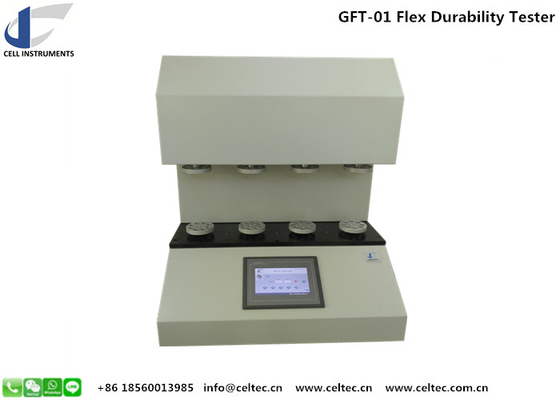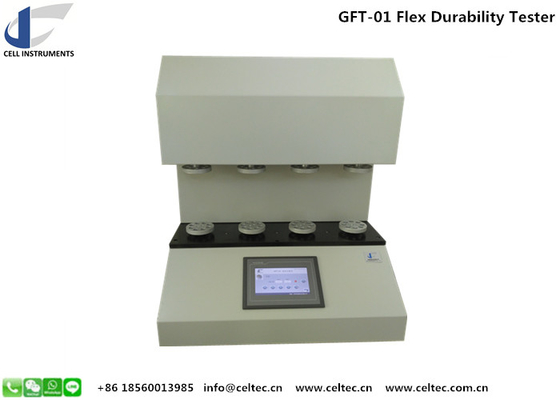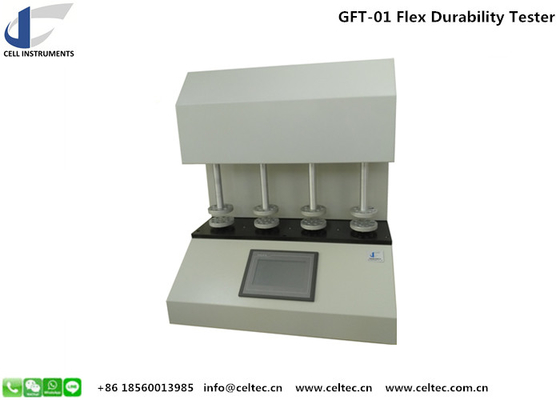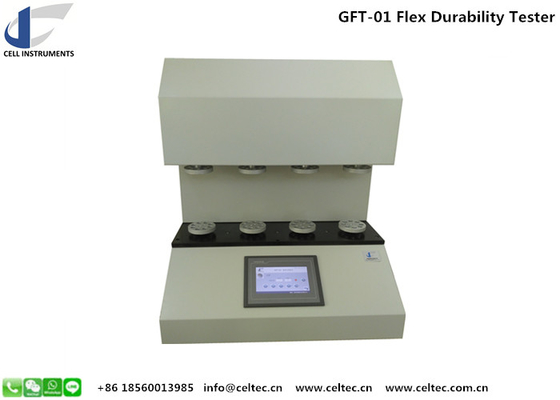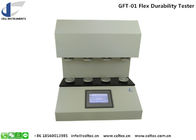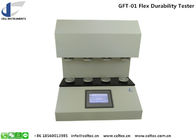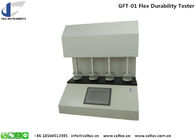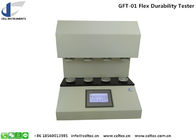Material Flex Crack Resistance Tester Horizontal Mandrel Multi Station Astm F392 Durability Tester

Contact me for free samples and coupons.
WhatsApp:0086 18588475571
Wechat: 0086 18588475571
Skype: sales10@aixton.com
If you have any concern, we provide 24-hour online help.
x| Power | Electronic | Usage | Plastic Testing Machine,flex Durability |
|---|---|---|---|
| Product Name | Flex Durability Tester | Application | Durability Test Machine |
| Power Supply | AC 220 V 50 Hz | Function | Flex And Abrasion Test For Textile And Leather |
| Standard | ASTM F392 |
Material Flex Crack Resistance Tester Horizontal Mandrel Multi Station Astm F392 Durability Tester
Introduction to Material Flex Crack Resistance Tester
The Material Flex Crack Resistance Tester is an advanced laboratory instrument specifically engineered to evaluate the durability and crack resistance of flexible materials such as plastic films, composite materials, and coating layers. Commonly referred to as the Gelbo Flex Tester or film torsion and flexing tester, this instrument provides critical insights into how materials behave under repetitive twisting and compressive stress, helping manufacturers ensure product performance and integrity in real-world applications.
![]()
Designed in compliance with ASTM F392, this tester is widely used in the packaging, pharmaceutical, food, beverage, and chemical industries, as well as in academic and research institutions. The Material Flex Crack Resistance Tester is an essential quality control tool in laboratories seeking accurate and repeatable testing results for material flexibility and endurance.
Key Features of the Material Flex Crack Resistance Tester
-
Multi-Station Testing Efficiency: Equipped with 4 test stations, allowing multiple samples to be evaluated simultaneously for higher throughput in laboratory settings.
-
High Precision Flex Testing: Flexing action simulates real-life torsion and compression with a 440° twist in the first 90 mm of stroke, followed by a 65 mm horizontal movement.
-
Adjustable Flex Frequency: Operates at 45 cycles per minute, with customizable test frequency to meet diverse material testing requirements.
-
Touchscreen Operation: Features an intuitive 7-inch color touchscreen and PLC control system, ensuring ease of operation and test configuration.
-
ASTM F392 Test Modes: Includes 5 standardized test modes (Condition A, B, C, D, and E), providing full flexibility to conduct tests according to recognized international standards.
-
Advanced Safety & Usability: Protective front cover enhances safety, while micro-printer output streamlines documentation and reporting.
-
Long & Short Stroke Switching: Quickly shift between stroke lengths based on sample and test requirements, improving workflow efficiency.
-
Flexible Sample Compatibility: Accommodates samples sized 280 mm x 200 mm, ideal for testing various flexible packaging materials and laminates.
Why Use the Material Flex Crack Resistance Tester?
-
Ensure Product Durability: Simulates repeated mechanical stresses that materials experience during packaging, shipping, and handling.
-
Verify Barrier Performance: Identifies the formation of pinholes and changes in permeability, crucial for products requiring moisture or air resistance.
-
Comply with ASTM Standards: Meets the ASTM F392 standard for evaluating flex durability of flexible barrier materials, ensuring international compliance.
-
Reduce Failure Rates: Helps predict and eliminate weak points in material design and processing, saving time and resources in product development.
-
Cross-Industry Applications: Ideal for industries where packaging integrity, product safety, and long shelf life are essential.
Applications of Material Flex Crack Resistance Tester
The Material Flex Crack Resistance Tester is commonly used to test:
-
Flexible packaging films for snacks, frozen foods, and pharmaceuticals
-
Barrier films and laminates for medical device packaging
-
Plastic-coated materials used in beverage and dairy cartons
-
Pharmaceutical blister packs requiring sterile barrier performance
-
Industrial films and wraps for automotive or electronics protection
This instrument is widely adopted by packaging manufacturers, material suppliers, food and beverage companies, medical product companies, and university research labs that focus on product development, material engineering, and quality assurance.
Working Principle
The working principle of the Material Flex Crack Resistance Tester is based on a combined twisting and horizontal motion that mimics real-world mechanical stress. A rectangular sample (280 mm x 200 mm) is mounted between two mandrels. As the mandrels twist (440°) and move horizontally (65 mm), the material undergoes simultaneous torsional and compressive flexing. This repetitive strain can lead to the formation of microscopic cracks or pinholes, which compromise material integrity.
By monitoring the occurrence of flex failure through pinhole detection or permeability changes, manufacturers can assess a material’s suitability for specific end-use applications.
Technical Specifications
| Parameter | Specification |
|---|---|
| Flex Frequency | 45 cycles per minute |
| Flex Angle | 440° (90 mm) or 400° (80 mm) |
| Horizontal Stroke | 155 mm or 80 mm |
| Number of Stations | 4 |
| Sample Size | 280 mm x 200 mm |
| Display | 7-inch Touch Screen |
| Control System | PLC |
| Test Modes | 5 (ASTM F392: Condition A, B, C, D, E) |
| Printer | Built-in Micro Printer |
| Safety | Protective Front Cover |
Advantages for Your Lab
-
Scalable Testing: Suitable for high-volume testing labs thanks to its multi-station setup.
-
International Compliance: Ensure your packaging meets stringent global quality standards.
-
Enhanced Reliability: Built with industrial-grade components to deliver consistent test performance.
-
Customizable Settings: Allows labs to configure tests according to various industry conditions.
Compliance and Standards
The Material Flex Crack Resistance Tester is compliant with ASTM F392, the standard method for determining the flex resistance of flexible barrier materials. This ensures that testing is accurate, repeatable, and internationally recognized, giving your products a competitive edge in the global marketplace.
Why Choose Our Material Flex Crack Resistance Tester?
Our model of the Material Flex Crack Resistance Tester is developed with advanced control logic and user-centered design, making it the most efficient and reliable choice in the market. With support for test data storage, real-time monitoring, and automatic cycle control, it significantly enhances laboratory productivity while delivering highly accurate results.
As a trusted manufacturer of material testing instruments, we serve customers across industries such as pharmaceuticals, food packaging, medical devices, textiles, chemicals, and academic research. We also offer full technical support, training, and calibration services to ensure that your operations run smoothly from day one.
Recommended Use Scenarios
-
Quality Control Labs: For routine packaging material evaluations.
-
R&D Departments: To test new material formulations or multilayer barrier films.
-
Compliance Testing: When preparing documentation for regulatory approval or certifications.
-
University Labs: Ideal for material science education and innovation projects.
FAQs: Material Flex Crack Resistance Tester
Q1: What is the main purpose of a Material Flex Crack Resistance Tester?
A1: It is used to evaluate the durability and crack resistance of flexible materials like films and laminates under repeated flexing stress.
Q2: What standard does the tester comply with?
A2: It complies with ASTM F392, a widely recognized standard for flex resistance testing of flexible barrier materials.
Q3: How many samples can be tested at the same time?
A3: The instrument features four testing stations, allowing up to four samples to be tested simultaneously.
Q4: What materials can be tested using this instrument?
A4: It is suitable for testing plastic films, aluminum foils, laminates, barrier packaging, and coated materials.
Q5: What are the typical industries using this tester?
A5: Industries include packaging, pharmaceuticals, food and beverage, medical devices, and academic research.
![]()



